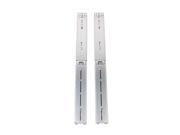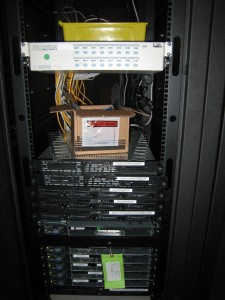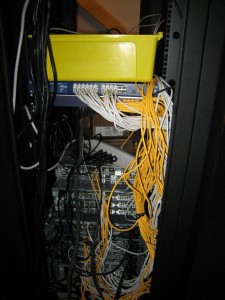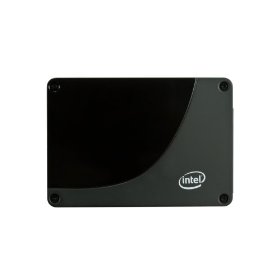August 24th, 2009
My company is trying to save money so we are moving off of renting servers to buying our own servers and host them ourselves in a co-location space. It was a quite stressful process from drafting machine specs to putting servers together and installing them at the data center. It took me a month to decide on all the parts to buy, 2 days to put the servers together and 2 days to install them at the data center. Why 2 days to install them at the data center? That’s because the rails (Antec 20″ rackmounting side rails) I bought weren’t really made for 1U servers. They are too tall (wide) to stack on top of each other. I believe these rails are probably made for 2U. The rails itself is very solid though. Here is what the rails look like:


We were juggling on our first day at the data center moving servers around trying to fit them in without wasting space. Basically, in order to fit this rails, we need to skip one nut on the rack. Which means, we would loose 1U for every 3 servers. That kinda defeat the purpose of purchasing 1U cases. We ended up only using two of these rails and stack 5 machines on top of a set of rails. This rails is very well built and it hold up very well. We are shopping for 1U rails now to refit the machines once we receive new rails.
Here is a couple pictures of what our rack look like:

Front of the servers on a rack

Back of the servers on a rack
Posted in Computing | 2 Comments »
July 29th, 2009


I just purchased this low-cost laser printer for work for less than $300. I have to say most of the reviews I read about this printer is true. It’s slow on startup (about a minute) and noisy when printing but print quality is excellent. The best part, it came with a full cartridge set instead of a starter pack. The cartridge set would cost a couple hundred dollars alone. You can’t really go wrong with this printer for the price.
One thing of warning though. The print server on this printer is wide open by default and the FTP port is also opened (you can print stuffs by ftping stuffs to the ftp port). I would suggest disabling FTP and set up a password if you are on a shared network in case some deadbeats may discover the FTP port and start dumping stuffs there for backup.
Posted in Computing, Electronics | 9 Comments »
May 26th, 2009


I finally took the plunge and bought this drive from Amazon after days of research. What pushed me over to actually make the purchase is after I used it on a friend’s Macbook. I hesitated to buy because I read a lot mixed reviews about SSD. There are two types of SSD. One type is called SLC and the other type is called MLC. There are a lot of info about SLC vs MLC out on the net so I’m not going to try to explain the technical difference between the two. Basically, SLC is the holy grail because it’s fast in both read and write. MLC is as fast as SLC in read but not as fast in write and most of the MLC drives slow down dramatically with concurrent writes. SLC is suitable as a boot drive and MLC is generally not recommended to use as boot drive because of slow write speed and performance degradation on concurrent writes. Also, SLC has longer life than MLC.
after days of research. What pushed me over to actually make the purchase is after I used it on a friend’s Macbook. I hesitated to buy because I read a lot mixed reviews about SSD. There are two types of SSD. One type is called SLC and the other type is called MLC. There are a lot of info about SLC vs MLC out on the net so I’m not going to try to explain the technical difference between the two. Basically, SLC is the holy grail because it’s fast in both read and write. MLC is as fast as SLC in read but not as fast in write and most of the MLC drives slow down dramatically with concurrent writes. SLC is suitable as a boot drive and MLC is generally not recommended to use as boot drive because of slow write speed and performance degradation on concurrent writes. Also, SLC has longer life than MLC.
Currently, Intel is the leading vendor that makes a reliable and reasonably fast MLC SSD. Some people commented that Intel’s SLC drive is the only way to go for SSD and their MLC drive is only good for data storage. I have also heard that Intel’s MLC drive is passable as a boot drive. The SLC drive costs almost twice as much as a MLC drive. It’s really out of the question for me to even consider a SLC drive. For me, the 80GB Intel X25-M is the only thing that’s affordable (around $325) with reasonable performance. Luckily, a friend of mine installed the 160GB version on his Macbook so I got the chance to see it in action. I was really amazed by its performance. Photoshop loaded in less than 10 seconds and Eclipse (a Java IDE) loaded in less than 5 seconds. Both Photoshop and Eclipse used to take about a minute to load in the same laptop when it was running on a hard drive.
is the only thing that’s affordable (around $325) with reasonable performance. Luckily, a friend of mine installed the 160GB version on his Macbook so I got the chance to see it in action. I was really amazed by its performance. Photoshop loaded in less than 10 seconds and Eclipse (a Java IDE) loaded in less than 5 seconds. Both Photoshop and Eclipse used to take about a minute to load in the same laptop when it was running on a hard drive.
I ordered a 80GB Intel X25-M immediately after testing on my friend’s Macbook. I use Ubuntu myself on a Lenovo Thinkpad X61 (an excellent laptop btw). My boot time reduced from couple minutes to 30 seconds after I switched to this SSD. I’m extremely happy with the performance. Contrary to what some people claimed that the drive would slow down a lot with concurrent write requests, I barely noticed any slow down. Everything loaded instantaneouly. I feel like I missed out a lot for spending the past few weeks doing research on SSD. I should have just take the plunge when the price dropped to $325. If you are still undecided, I say just do it because it totally worth the money. It’s not cheap compare to a hard drive but the performance improvement will sure help in your productivity to make up for it.
Posted in Electronics | 4 Comments »








